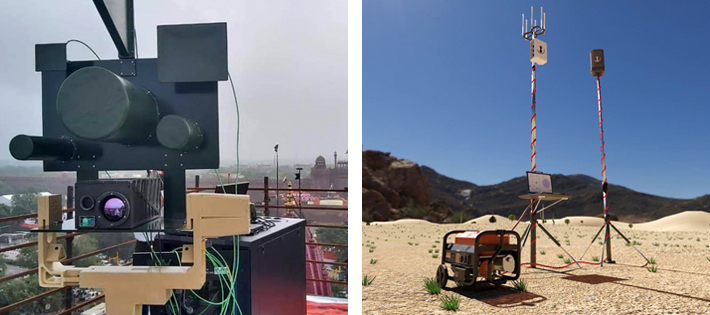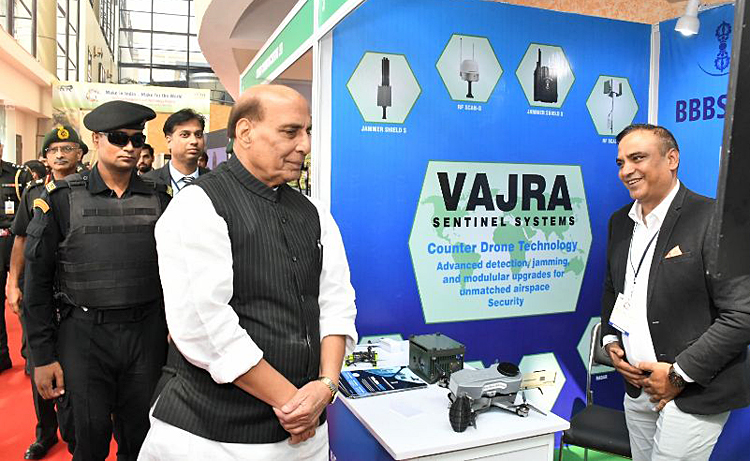INDIAN ARMED FORCES CHIEFS ON
OUR RELENTLESS AND FOCUSED PUBLISHING EFFORTS

SP Guide Publications puts forth a well compiled articulation of issues, pursuits and accomplishments of the Indian Army, over the years

I am confident that SP Guide Publications would continue to inform, inspire and influence.

My compliments to SP Guide Publications for informative and credible reportage on contemporary aerospace issues over the past six decades.
Drone Interceptors
India's Cutting-Edge Response to Drone Threats
 |
The Author is Former Director General of Information Systems and A Special Forces Veteran, Indian Army |

In backdrop of the raging swarm drones war in Ukraine, media reports of March 21, 2024, state that the Indian Army has introduced seven new indigenous drone-detection and interdiction systems (IDD&IS) along the Line of Actual Control (LAC) with China. These systems can jam enemy drones and use lasers to eliminate them, with a detection range of 5 to 8 km. The vehicle-based IDD&IS provides for both 'soft kill' of hostile drones through jamming and 'hard kill' with lasers. The 'soft kill' can jam the drones at ranges from 2 to 5 km and the effective 'hard kill' range is over 800 metres.
Developed by the DRDO and Bharat Electronics Limited (BEL), these IDD&IS are Mark-1 variants deployed by the Army, adding to the existing counter-drone systems
Developed by the DRDO and Bharat Electronics Limited (BEL), these IDD&IS are Mark-1 variants deployed by the Army, adding to the existing counter-drone systems. They provide an integrated capability to detect low radar cross-section drones and enable their destruction through integrated application of soft and hard kills. India has arrived late on the scene compared to other countries developing drones and counter-drone systems. However, after the DRDO developed counter-drone systems with 2 kilowatt to 10 kilowatt lasers, the Armed Forces have ordered 23 such systems costing around ₹400 crore. The DRDO is also in the process of developing more potent directed energy weapon (DEW) systems like high-energy lasers and high-powered microwaves for enhanced security measures.

The indigenous private sector also has risen to the challenge of developing drones and counter-drone systems needed to deal with rising threats to India's national security. On March 11, 2024, Indian startup Big Bang Boom Solutions Pvt Ltd (BBBS) has secured an order worth more than ₹200 crore from the Indian Army and the Indian Air Force (IAF) under the Indian Defence Exhibition (IDEX) initiative. This is one of the largest contracts signed by the Ministry of Defence (MoD) with an Indian start-up. BBBS specialises in deep-tech products especially, anti-drone solutions. The anti-drone technology provides a game-changing response to the mounting threat posed by drones and unmanned aircraft systems (UAS).

BBBS's 'Vajra' Sentinel System, an anti-drone defence system, is a state-of-the-art solution designed to detect, track, and neutralise drones at extraordinary ranges. It utilises passive RF sensor technology to eliminate false alarms, and its sensor and jammer combination meets stringent military standard specifications for durability and reliability. It has several state-of-the-art tech improvements such as AESA radar and kamikaze drones which can be upgraded on demand by the user.
BBBS specialises in deep-tech products especially, anti-drone solutions. The anti-drone technology provides a game-changing response to the mounting threat posed by drones and unmanned aircraft systems (UAS).
The system's core sensor built around artificial intelligence (AI) and computer vision algorithms enables precise identification, classification and location identification of drones. Additionally, its sophisticated decision-making matrix enables autonomous decision-making for countermeasures such as signal jamming and other countermeasures. BBBS is to commence execution of the order immediately, with a focus on timely delivery and comprehensive training.
Concurrently, news reports of March 19, 2024, indicate that 'Solar Industries India Limited' (SOLARINDS) has developed 'Bhargavastra', an indigenous micro missile system to counter swarm drones. The system offers a powerful countermeasure against the growing drone threat and potential intrusions in the Indian airspace. Specifications of Bhargavastra include: detection range – exceeds 5 km, enabling identification of targets with a radar cross-section (RCS) as small as 0.01 sq metres; rapid response – less than 16 seconds from detection to interception; multi-target engagement – ability to simultaneously detect, track and engage up to 64 targets, effectively neutralising swarm drones, and; micro-missile kill system - employs micro-missiles that 'lock-on' after launch and have homing capabilities. Multiple micro-missiles can be launched with one second intervals.
Solar Industries India Limited (SOLARINDS) has developed 'Bhargavastra', an indigenous micro missile system to counter swarm drones

Among global developments, South Korea is set to unveil a groundbreaking system designed to intercept drones at distances of up to 30 km using a tube-launched, unmanned aerial system. This system is expected to be similar to America's "Coyote" low-cost drone interceptor system. The new South Korean system is based on a specialised trailer equipped with tube-launcher modules for interceptor drones. Upon detecting an enemy UAV, an interceptor drone is immediately launched from the launcher container for interception. The launched interceptor drone is equipped with detection radar and a data transmission line connected to ground control equipment. Prior to approaching the hostile UAV, the detection radar informs the interceptor drone of the enemy UAV's location through the data transmission channel and closes in on it. When it gets close enough, the electro-optical/infrared (EO/IR) guidance system installed on the interceptor drone's head tracks the drone to its end and intercepts it through self-blow up.
India needs a mission-mode national program on DEWs considering the China challenge and the continued confrontation along the entire LAC
The Indian Armed Forces are focusing on inducting different kinds of effective counter-drone systems; ranging from jamming, spoofing and blinding systems to disrupt the satellite or video command and control links of drones to laser-based DEWs. The DRDO is now working on DEWs with power levels of nearly 30-50 kilowatt, in line with the short, medium and long-term goals, in line with developing DEWs with higher power levels in the next three to five years and longer operational ranges. India needs a mission-mode national program on DEWs considering the China challenge and the continued confrontation along the entire LAC.





